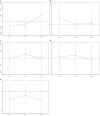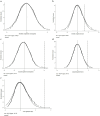The system effect and group benefit equity of long-term care insurance from the perspective of short-term policy pilot
- PMID: 40520311
- PMCID: PMC12162715
- DOI: 10.3389/fpubh.2025.1580349
The system effect and group benefit equity of long-term care insurance from the perspective of short-term policy pilot
Abstract
Methods: This study focuses on the long-term care insurance (LTCI) policy pilot, using the CHARLS database to continuously track survey data. It constructs a difference in-difference model based on city, time, coverage, and beneficiaries to accurately identify policy coverage and empirically examine the institutional effect of the long-term care insurance policy pilot and the fairness of group benefits.
Results: The results indicate that the policy pilot has a significant positive impact on the overall medical consumption of disabled older adults, with impacts on monthly outpatient consumption, annual hospitalization consumption, annual hospitalization times, and last hospitalization days of 0.7064, 0.4142, 0.0887, and 1.5607, respectively. In addition, the LTCI policy pilot significantly and positively affected disability-related health indicators such as individual self-assessment health, ADL disability, and the number of serious diseases, with effect sizes of 0.8677, 1.0854, and 0.6668, respectively.
Discussion: The results regarding group benefit equity show that the LTCI policy pilot can improve the equity of medical consumption and disability-related health among groups; however, over time, it may exacerbate the inequality of medical consumption and disability-related health among disabled older adults in the treatment group. Based on this, the study finds that the LTCI policy pilot has effects on medical consumption and disability-related health for disabled older adults, primarily driven by the moral hazard associated with the assessed individuals obtaining LTCI treatment due to the short-term policy pilot.
Keywords: disability; inequality; institutional effect; long-term care insurance; policy pilot.
Copyright © 2025 He and Liu.
Conflict of interest statement
The authors declare that the research was conducted in the absence of any commercial or financial relationships that could be construed as a potential conflict of interest.
Figures



Similar articles
-
Evaluating the long-term care insurance policy from medical expenses and health security equity perspective: evidence from China.Arch Public Health. 2022 Jan 4;80(1):3. doi: 10.1186/s13690-021-00761-7. Arch Public Health. 2022. PMID: 34983634 Free PMC article.
-
A quantitative evaluation study of China's Long-Term Care insurance policies based on the PMC index model: A case study of 16 pilot policy texts.PLoS One. 2025 Apr 11;20(4):e0321057. doi: 10.1371/journal.pone.0321057. eCollection 2025. PLoS One. 2025. PMID: 40215459 Free PMC article.
-
Health effects of long-term care insurance on spouses of disabled people: a quasi-experimental study.BMC Geriatr. 2023 Oct 19;23(1):679. doi: 10.1186/s12877-023-04344-9. BMC Geriatr. 2023. PMID: 37858050 Free PMC article.
-
Review of evolution of the public long-term care insurance (LTCI) system in different countries: influence and challenge.BMC Health Serv Res. 2020 Nov 20;20(1):1057. doi: 10.1186/s12913-020-05878-z. BMC Health Serv Res. 2020. PMID: 33218328 Free PMC article. Review.
-
Evaluation of long-term care insurance pilot city policies in China: a cross-sectional study.Front Public Health. 2025 Mar 21;13:1570794. doi: 10.3389/fpubh.2025.1570794. eCollection 2025. Front Public Health. 2025. PMID: 40190763 Free PMC article. Review.
References
-
- Ma C, Yu QW, Song Z. Long-term care insurance, the control of medical expenses and "value-based health care". China Industrial Econ. (2019) 12:42–59. doi: 10.19581/j.cnki.ciejournal.2019.12.003 - DOI
-
- Liu H. Formal and informal care: complementary or substitutes in care for elderly people? Empirical evidence from China. SAGE Open. (2021) 11:1–16. doi: 10.1177/21582440211016413, PMID: - DOI
MeSH terms
LinkOut - more resources
Full Text Sources
Medical

